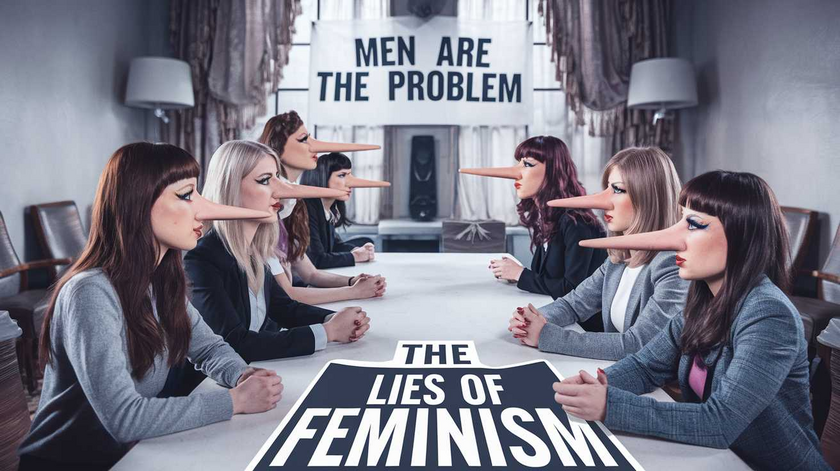In nearly every crusade feminists have waged, there have been both lies and exaggerations. They have consistently stretched the truth and, in many cases, outright fabricated claims to push society toward a female supremacist agenda.
As I began compiling a list of the many lies told by feminism over the years, I quickly became overwhelmed. There were so many that it was frustrating to organize them all. Then I had an idea: "I wonder what AI would say about this?" Admittedly, I assumed AI would simply repeat the standard “women good“ party line, but I decided to ask anyway. My question was straightforward: "Can you give me a list of feminist lies or exaggerations? Include the lie as the first part, followed by the facts that refute it."
When I plugged in that question, to my surprise, AI generated 20 responses almost immediately. Then it asked, "Do you want more?" Naturally, I said, "Hell yes!" More responses followed. The AI then asked, "Do you want to specify a particular topic?" Intrigued, I said, "Domestic violence." From there, it generated 10 more responses specific to that issue. This continued until I had amassed over 150 responses, spanning various topics.
As I read through the results, it became painfully clear how deeply embedded and pervasive these deceptions have been. A trusting public has swallowed these narratives as if they were 100% true and, to this day, continues to vehemently defend them, despite overwhelming evidence to the contrary.
However, there now seems to be a shift occurring in the United States. Slowly but surely, people are beginning to wake up to the plight of men—an issue that has been systematically obscured for the last 50 years by a pathologically gynocentric parade of false statements. These narratives have painted women as legitimate victims of systemic oppression for thousands of years, while ignoring or dismissing the experiences and challenges faced by men. Maybe with this shift the public is closer to hearing the truth?
I’ll share all 150 examples below. Keep in mind, this isn’t coming from an MRA or a specific ideology—it’s purely AI-generated. In a few spots, I’ve added my own comments, marked with my initials. You’ll also see that ChatGPT included notes under certain sections labeled “Broader Context,” which summarize or tie together specific points.
Let me know what you think of the list and the scope of deception it reveals. Also please put in the comments any areas that are missing.
150 Feminist Lies and Exaggerations
1. Wage Gap: Women earn 77 cents for every dollar a man earns.
The claim implies that women are paid less than men for the same work due to systemic discrimination. However, when controlling for factors like job type, experience, education, and hours worked, the gap largely disappears, revealing differences in choices rather than unequal pay for equal work.
2. One in five women will be sexually assaulted in college.
This statistic is often cited to highlight a supposed epidemic of campus sexual violence. Yet, it comes from surveys with broad definitions of assault and self-reporting, and government crime statistics indicate the actual rate is much lower.
3. Super Bowl Domestic Violence Spike: Domestic violence surges on Super Bowl Sunday.
Feminists claimed that domestic violence spikes during the Super Bowl due to male aggression triggered by sports. This has been thoroughly debunked by studies showing no such trend, and even the originator of the myth admitted it was fabricated.
4. A woman is beaten every 15 seconds in the U.S.
This claim, popularized in the 1990s, was based on questionable extrapolations from a single outdated study. More reliable data shows that intimate partner violence rates are far lower and not so dramatically gendered.
5. Women have been universally oppressed throughout history.
This claim suggests women have always been victims without power or influence. Historical analysis reveals that women often held critical roles in families, communities, and societies, and were protected by laws and customs that recognized their unique contributions.
6. Domestic violence is mostly committed by men against women.
Feminist narratives often portray domestic violence as a one-sided male-perpetrated issue. However, studies consistently show that intimate partner violence is roughly reciprocal, with men and women perpetrating at similar rates, though male victims are less likely to report.
7. Gender is a social construct with no biological basis.
The idea posits that all gender differences are learned and societal rather than inherent. Modern neuroscience and biology affirm that significant, measurable differences exist between male and female brains and hormonal influences, influencing behavior and preferences.
8. 2-8% of sexual assault allegations are false.
This statistic is often cited as proof that false allegations are rare. However, broader studies, such as Kanin’s work, suggest the rate may be higher, and the strict definition of "false" excludes cases that lack evidence or remain unresolved.
9. Women are underrepresented in STEM due to discrimination.
The claim assumes gender disparity in STEM is caused by bias against women. Yet, in more gender-equal societies, women are less likely to choose STEM careers, reflecting personal interests rather than systemic barriers.
10. Women couldn’t own property or vote before feminism.
Feminists often claim women had no legal rights before feminist movements. In reality, many societies allowed women to own property, run businesses, and wield influence, and women's suffrage emerged from broader social changes rather than solely feminist efforts.
11. "Rule of Thumb": Men could legally beat their wives with sticks no thicker than their thumbs.
This myth claims ancient laws sanctioned wife-beating within specific limits. Historical research shows no evidence of such laws, and the phrase likely originates from carpentry, not domestic violence.
12. 150,000 women die annually from anorexia.
This statistic was popularized to highlight issues with eating disorders. It was later revealed to be a gross exaggeration; the actual annual mortality rate from anorexia is significantly lower. (estimates are about 10,000 trg)
13. Women suffer more in war than men.
Feminists sometimes argue women are the primary victims of war due to displacement and sexual violence. However, men overwhelmingly bear the brunt of war casualties and deaths, often conscripted into combat or targeted directly.
14. Women have fewer rights than men globally.
This claim suggests that women are oppressed in every society due to systematic bias. In many countries, legal frameworks actually favor women, such as in custody disputes, alimony laws, and protections against gender-based violence.
15. Marriage is a tool of female oppression.
Feminists argue marriage subjugates women to male dominance. Yet, data shows that married women tend to be happier, healthier, and live longer than their single counterparts, and marriage benefits men and women differently but positively.
16. Girls are just as interested in sports as boys but lack opportunities.
This claim is often used to justify disproportionate funding for women's sports. Studies show that boys, on average, have stronger natural preferences for competitive physical activities than girls, explaining participation gaps.
17. Women’s suffrage was universally opposed by men.
The narrative assumes men universally resisted giving women the vote. In fact, many men supported women's suffrage, and some women opposed it, especially in regions where suffrage was linked to wartime conscription.
18. Sexual harassment is rampant, and women are powerless to stop it.
Feminists claim workplaces are universally hostile to women. While harassment exists, modern laws and workplace policies in many countries provide robust protections and have significantly reduced such incidents over time.
19. 1 in 3 women globally will experience domestic violence.
This widely-cited claim is based on aggregated data with inconsistent definitions of violence. Many studies find that the actual prevalence varies greatly across regions, and male victims are often underreported. (1 in)
20. Women were burned as witches for being independent or intelligent.
Feminists argue witch hunts targeted women who defied patriarchal norms. Historical analysis shows that accusations often stemmed from local disputes, fear of the supernatural, or political motives, and men were also accused and executed as witches.
21. Feminism is the sole reason women gained the right to vote.
The narrative credits feminism exclusively for suffrage achievements. However, broader social, economic, and political shifts, such as women’s contributions during wars, were significant factors in achieving voting rights.
22. Child custody is biased against mothers.
Feminists claim that courts favor fathers in custody disputes. In reality, family courts overwhelmingly award custody to mothers, often assuming women are naturally better caregivers.
23. 70% of women experience imposter syndrome because of systemic sexism.
This claim attributes feelings of inadequacy in women to external oppression. Research shows imposter syndrome is common in both genders and is influenced more by personality traits and workplace culture than systemic sexism.
24. Pornography causes violence against women.
Feminists argue that pornography directly leads to increased violence against women. Studies have found no consistent causal link; some research even suggests exposure to pornography correlates with lower rates of sexual violence.
25. Women are oppressed because of "unpaid labor" like housework.
This claim frames housework as a form of systemic exploitation. Studies show that while women often do more household chores, men tend to work longer hours in paid labor, resulting in similar total workloads.
26. Women earn less in retirement due to discrimination.
Feminists claim the gender pension gap is a result of systemic inequality. The disparity is largely due to women spending more years out of the workforce for caregiving and opting for less risky investment strategies.
27. The majority of mass shooters are motivated by misogyny.
Feminists often assert that mass shootings are driven by male hatred of women. Studies on mass shooter motives show a complex mix of mental health issues, personal grievances, and social alienation, with misogyny being a rare factor.
28. Only men commit war crimes like sexual violence.
Feminists frame sexual violence in war as a uniquely male-perpetrated atrocity. However, historical records document women committing war crimes, including sexual violence and participation in atrocities.
29. Women have historically been excluded from education.
Feminists claim women were universally denied education. In many societies, elite women were educated, and restrictions often reflected class dynamics rather than gender alone.
30. Divorce leaves most women impoverished due to male exploitation.
Feminists argue that divorce disproportionately harms women. While divorce can be financially challenging, many systems favor women with alimony, child support, and favorable asset division policies.
31. Women are forced into beauty standards created by men.
Feminists claim male-dominated industries impose unattainable beauty ideals on women. Research indicates women are the primary consumers of beauty products, and beauty norms are often reinforced more by female competition than male expectations.
32. Abortion is necessary for women’s mental health.
Feminists argue that abortion access is essential for mental well-being. Studies show mixed results, with some women experiencing regret and negative mental health outcomes post-abortion, while others report relief.
33. Women couldn’t own property before modern feminism.
The claim suggests women had no property rights until recent feminist activism. Historical records show that many societies allowed women to inherit, own, and manage property, especially widows and unmarried women.
34. Feminist reforms have eradicated poverty for women.
Feminists claim their efforts have significantly reduced women’s poverty. In reality, single motherhood and lower workforce participation remain significant contributors to poverty among women, regardless of feminist reforms.
35. Only women are victimized by workplace discrimination.
Feminists assert that discrimination in hiring, promotion, and pay disproportionately harms women. Evidence shows men face discrimination in certain fields, such as education and nursing, where female workers dominate.
36. Women in medieval Europe had no power or influence.
Feminists argue medieval women were entirely subjugated. However, historical accounts show women like Eleanor of Aquitaine and Hildegard of Bingen wielded considerable political and social power.
37. Male-dominated fields are hostile to women.
Feminists often depict male-dominated professions as actively excluding women. While challenges exist, many industries actively encourage female participation through scholarships, quotas, and mentorship programs.
38. Women have been excluded from medical research, resulting in poorer health outcomes.
Feminists claim that women were systematically excluded from clinical trials and medical studies, leaving their health needs ignored. While women were underrepresented in some early trials due to concerns like hormonal variability and pregnancy risks, modern research standards mandate gender inclusion, and many studies specifically focus on women's health issues.
39. Women were excluded from medical research until the 1990s.
This claim suggests systemic neglect of women’s health in clinical trials. While it's true that women were excluded from some early studies, this was primarily due to concerns about potential harm to fetuses and the complexity of accounting for hormonal cycles. By the 1990s, regulatory changes like the National Institutes of Health Revitalization Act of 1993 mandated the inclusion of women in federally funded research.
40. Male bodies are the "default" in medicine, leaving women at a disadvantage.
Feminists argue that using male bodies as the standard for medical research has resulted in poorer healthcare for women. While early research often prioritized men to avoid variability from menstrual cycles, modern medicine recognizes sex-based differences, and researchers now study both male and female physiology to tailor treatments.
41. Women’s unique health needs, like heart disease, are ignored in research.
This claim gained traction because early heart disease studies focused on men. However, the medical community has since recognized that heart disease manifests differently in women, leading to targeted research and improved diagnostic tools and treatments for women.
42. Medications are only tested on men, putting women at risk.
Feminists argue that drug trials conducted predominantly on men result in unsafe medications for women. While some older studies excluded women, current clinical trials are required to include diverse populations, and sex-specific effects are closely monitored to ensure safety for all patients.
43. Women are excluded because of sexism in medical research.
This claim frames the issue as deliberate discrimination against women. In reality, earlier exclusions were often motivated by ethical concerns over pregnancy and protecting reproductive health, not sexism, and these gaps have since been addressed by policy changes.
44. Women’s pain and symptoms are dismissed because of male-centered research.
Feminists argue that women’s symptoms, particularly for conditions like chronic pain, are ignored due to reliance on male-centered studies. While there is evidence of disparities in pain treatment, these are now being actively addressed, with growing research into conditions that disproportionately affect women, such as fibromyalgia and endometriosis.
45. Female animals are not used in preclinical trials, skewing results.
Feminists highlight the historical preference for male animals in early drug testing, claiming it harms women. While this was true in the past, recent guidelines encourage the inclusion of both male and female animals to better understand sex-specific responses in early-stage research.
46. Women's mental health research has been neglected.
Feminists argue that conditions like postpartum depression and menopause-related mental health issues are ignored. However, these areas have become significant fields of study in recent decades, with dedicated funding and awareness campaigns leading to better understanding and treatment options.
Broader Context
The narrative of exclusion often overlooks progress in addressing these gaps, such as:
Increased funding for women's health initiatives, like breast cancer research and maternal health programs.
Policies mandating the inclusion of women and minorities in research (e.g., NIH guidelines).
A growing focus on sex-based differences in diseases, medication responses, and health outcomes.
While historical underrepresentation in research is a valid critique, framing it as deliberate oppression neglects the ethical, biological, and logistical factors that contributed to the disparity. Today, researchers and institutions are actively working to ensure equity in medical studies.
47. Girls are systematically disadvantaged in education due to sexism.
Feminists claim that patriarchal systems in schools favor boys, leaving girls behind academically. However, data from the last few decades shows that girls outperform boys in most academic measures, including grades, high school graduation rates, and college enrollment, indicating that if biases exist, they may disproportionately affect boys.
48. Textbooks and curricula promote male dominance by excluding women.
Feminists argue that history and literature curricula are male-centered, sidelining women's contributions. While early textbooks often focused on male figures, modern curricula include significant efforts to highlight women’s achievements across all fields, sometimes to the point of sidelining male contributions.
49. Girls are discouraged from pursuing STEM fields by sexist teachers and peers.
The claim suggests that societal biases dissuade girls from entering STEM. Research shows that while there are societal influences, girls often self-select away from STEM careers based on interests, not discrimination, and countries with the most gender equality see the widest STEM gender gaps due to these preferences.
50. Dress codes unfairly target girls and perpetuate rape culture.
Feminists assert that school dress codes sexualize girls and blame them for distracting boys. While dress codes sometimes target specific clothing styles, their intent is generally to maintain a professional environment, and reforms in many schools have aimed at making these rules more gender-neutral.
51. Teachers give more attention and praise to boys than girls.
This claim suggests that boys receive preferential treatment in the classroom. Research reveals that while boys may receive more disciplinary attention, girls often get higher evaluations and encouragement due to their behavior and compliance with school norms.
52. Boys dominate classroom discussions, silencing girls.
Feminists argue that boys overshadow girls in academic discussions due to societal conditioning. Studies show that while boys may speak more frequently, girls tend to provide higher-quality responses and dominate in environments that value academic structure, like honors or AP classes.
53. Title IX was necessary to fix massive gender inequality in education.
Feminists claim that Title IX (passed in 1972) was essential to eliminate widespread discrimination against women in schools. While it addressed legitimate gaps in access to athletics and education, the law now sometimes skews opportunities unfairly against boys, particularly in sports, where male teams are cut to maintain compliance.
54. Women are underrepresented in higher education because of discrimination.
The narrative suggests that sexism keeps women out of college. Yet, women have outnumbered men in higher education for decades, comprising nearly 60% of college students today, with men being the ones lagging behind in enrollment and graduation rates.
55. Standardized tests are biased against girls.
Feminists claim standardized tests favor boys due to question design or test-taking strategies. While boys historically scored slightly higher on math portions, girls outperform boys in language arts and overall GPA, and test revisions have mitigated most gender disparities.
56. Single-sex education is necessary to empower girls.
Feminists argue that girls thrive in single-sex environments because they are free from male-dominated classrooms. Research shows mixed results, with single-sex education benefiting some girls but often failing to outperform coeducational systems in terms of academic outcomes.
Broader Context
In many areas, the educational system has shifted to address previous disparities for girls but now risks neglecting boys:
Grade Gap: Boys are more likely to be diagnosed with behavioral issues, receive lower grades, and drop out of high school.
Higher Education: Men are now significantly underrepresented in colleges, a trend that continues to grow.
Discipline: Boys are disproportionately punished in schools, potentially contributing to lower engagement and academic performance.
The narrative that girls are oppressed in education no longer aligns with the evidence. The focus on empowering girls has been largely successful, but many boys now face systemic challenges that remain unaddressed.
57. 1 in 4 women will be raped in their lifetime.
This statistic is often cited as evidence of a widespread epidemic of rape. However, it originates from surveys using broad definitions that include consensual but regretted encounters, while other data, like the National Crime Victimization Survey (NCVS), reports much lower rates of rape and sexual assault.
58. Rape is a tool of patriarchal oppression.
Feminists claim rape is systematically used to oppress women in male-dominated societies. While rape is a heinous crime that disproportionately affects women, evidence shows that men can also be victims, often overlooked due to societal biases and underreporting.
59. False rape accusations are exceedingly rare (2-8%).
Feminists argue that only a tiny fraction of rape allegations are false, using studies with strict definitions of "false." Broader research, such as Kanin's study, suggests higher rates of false reporting, particularly in cases where allegations are retracted or lack evidence, but exact numbers remain debated.
60. Victim-blaming is universal and systemic in rape cases.
The claim suggests society inherently blames victims for their assault, preventing justice. While some instances of victim-blaming occur, legal systems and public attitudes have significantly shifted toward supporting victims, as seen in widespread "believe the victim" campaigns and legislative reforms.
61. College campuses are 'rape cultures' where sexual assault is normalized.
This claim stems from surveys suggesting that 1 in 5 college women are sexually assaulted. However, these surveys often include non-criminal acts like unwanted touching or drunken regret, and official campus crime reports show far lower rates of forcible rape.
62. Most rapes go unpunished because of systemic bias against women.
Feminists argue that the justice system is designed to protect rapists and discredit victims. While rape cases are complex and often difficult to prosecute due to evidentiary challenges, most developed countries have laws specifically aimed at protecting victims and ensuring fair trials.
63. Marital rape was legal everywhere until feminists changed the law.
Feminists assert that before modern feminism, husbands had total legal authority over their wives’ bodies. While marital rape laws were slow to develop, many societies historically viewed consent as implicit in marriage but condemned extreme violence or coercion. Legal reforms now universally criminalize marital rape in many countries.
64. Rape is all about power and never about sex.
The claim asserts that rape is purely a crime of power and control rather than sexual desire. While power dynamics often play a role, studies show that sexual motives and opportunity are significant factors in many cases.
65. Rape kits go untested because the system doesn’t care about women.
Feminists highlight backlogs of untested rape kits as evidence of systemic indifference. While backlogs exist due to resource constraints, governments have invested heavily in clearing them and improving forensic processes in recent years.
66. Rape is always a male-on-female crime.
Feminists often overlook male victims and female perpetrators in discussions about rape. Data shows that men can also be victims of sexual assault, particularly in prisons, and female-perpetrated assaults are more common than typically acknowledged.
67. Rape has historically been about controlling women’s sexuality.
Feminists argue that laws against rape were created to protect men’s property (i.e., wives and daughters) rather than women themselves. While historical laws sometimes reflected patriarchal values, modern laws focus on personal autonomy and protecting all individuals, regardless of gender.
68. The military is rife with unchecked sexual violence against women.
Feminists often claim that female soldiers face systemic sexual violence in the military. While sexual assault is a serious problem in the armed forces, reforms, awareness campaigns, and increased reporting mechanisms have improved conditions significantly, and male victims in the military are also a significant but less-discussed group.
Broader Context
Rape is a serious issue that demands attention, but exaggerating or misrepresenting claims can:
Undermine trust in legal systems and institutions.
Create stigma against men, particularly with sweeping generalizations about "toxic masculinity."
Overlook male victims, who often face even greater barriers to reporting.
Focusing on accurate data and fair systems is essential to ensuring justice for all victims of sexual violence while maintaining the presumption of innocence for the accused.
69. Abortion is a constitutional right in the United States.
Feminists have argued that abortion is a constitutional right guaranteed by Roe v. Wade. However, the Supreme Court’s decision in Dobbs v. Jackson Women’s Health Organization clarified that the Constitution does not explicitly guarantee abortion, leaving the issue to states to legislate.
70. Overturning Roe v. Wade will lead to widespread deaths of women from unsafe abortions.
This claim asserts that restricting abortion will force women into dangerous, illegal procedures. Modern medicine, combined with abortion pills and safer options even in restrictive states, makes this scenario unlikely, and countries with strict abortion laws often report lower abortion-related mortality rates.
71. Most women who seek abortions do so because of rape or life-threatening conditions.
Feminists often emphasize these extreme cases to justify widespread abortion access. In reality, studies show that the majority of abortions are elective, with socioeconomic concerns being the primary reason cited, while cases involving rape, incest, or life-threatening conditions account for a small percentage.
72. Abortion is necessary for women’s mental health.
Feminists argue that abortion access is critical to preserving women’s mental well-being. However, research on this topic is mixed, with some studies showing relief post-abortion but others indicating higher rates of depression, anxiety, and regret, especially after later-term abortions.
73. Abortion bans criminalize women and put them in jail.
Feminists claim that abortion restrictions result in women being prosecuted. In most cases, abortion bans target providers, not women, and even restrictive laws often include exceptions for the mother’s health or in cases of rape or incest.
74. A fetus is just a clump of cells until viability.
This claim dehumanizes the fetus to support abortion access. Scientific consensus holds that human life begins at conception, with measurable development milestones like a heartbeat at six weeks and pain sensitivity by 20 weeks, making the "clump of cells" argument scientifically inaccurate.
75. Women have no alternative if abortion is banned.
Feminists argue that abortion is the only option for unwanted pregnancies. However, adoption and increased access to contraception provide viable alternatives, and many organizations offer support for women during and after pregnancy.
76. Restricting abortion disproportionately harms poor and minority women.
This claim suggests that abortion bans uniquely disadvantage underprivileged groups. While access issues exist, some communities see abortion as disproportionately used, with studies showing minority women undergoing abortions at higher rates, raising concerns about systemic exploitation rather than empowerment.
77. Late-term abortions are only performed for severe medical reasons.
Feminists often claim late-term abortions are rare and medically necessary. However, data indicates that while they are rare, many late-term abortions are elective, not tied to health risks, challenging the narrative that they are exclusively a medical emergency.
78. Abortion empowers women to control their own bodies.
This argument posits that abortion is essential for women’s autonomy. Critics argue that this overlooks the ethical complexity of balancing a woman’s rights with the fetus’s right to life and the societal responsibility to support both mother and child.
79. Abortion restrictions turn women into second-class citizens.
Feminists claim that restricting abortion denies women equality. In reality, abortion laws aim to address competing rights—the woman’s and the fetus’s—and many argue that equality doesn’t require unlimited access to abortion but rather better social support systems.
80. Pro-life movements are rooted in misogyny and control over women.
Feminists often claim opposition to abortion stems from a desire to control women. Pro-life advocates argue their stance is based on protecting fetal life, with many women leading the movement and citing ethical, moral, or religious reasons unrelated to sexism.
81. Women will lose access to contraception if abortion is restricted.
Feminists link abortion bans to a loss of birth control access. In reality, contraception is widely accepted even among many pro-life advocates, and no state has proposed banning contraception as part of abortion restrictions.
Broader Context
Abortion remains one of the most polarizing issues, but exaggerations or misrepresentations in feminist arguments often:
Oversimplify the ethical and scientific complexities surrounding abortion.
Dismiss the rights and perspectives of those advocating for fetal life.
Ignore the progress made in supporting women through alternatives like contraception, healthcare, and adoption services.
Framing the debate accurately and fairly is essential to finding compassionate and effective solutions.
82. Disagreeing with feminism means you’re a misogynist.
Feminists often claim that anyone opposing their views inherently hates or disrespects women. In reality, many critics of feminism support gender equality but take issue with specific feminist policies, narratives, or methods that they see as divisive or unfair.
83. Anti-feminists want to maintain male dominance.
This claim suggests that opposition to feminism stems from a desire to preserve patriarchy. Many critics, including women, argue that modern feminism has gone beyond addressing inequality and now promotes double standards or policies that harm men.
84. Anti-feminist women are "internalized misogynists."
Feminists often argue that women who reject feminism are brainwashed by patriarchy. This dismisses the agency of these women, who may have valid reasons for rejecting feminist ideologies, such as prioritizing family roles or disagreeing with victim-centered narratives.
85. Disagreeing with feminism is "violence against women."
Feminists sometimes equate verbal disagreement or criticism with physical harm. This conflation undermines real issues of violence by exaggerating the impact of dissenting views and stifles open dialogue.
86. Men’s rights activists (MRAs) are just misogynists in disguise.
Feminists claim that MRAs are simply men angry at losing power. In reality, many MRAs focus on genuine issues like high male suicide rates, unfair family court systems, and lack of support for male victims of domestic violence—issues feminism often overlooks.
87. Religious critics of feminism are regressive and anti-woman.
Feminists often portray religious individuals who critique feminism as clinging to outdated, oppressive traditions. Many religious critics, however, argue that their views promote a complementary, rather than adversarial, understanding of gender roles, rooted in mutual respect.
88. Criticizing feminism is equivalent to denying gender inequality exists.
Feminists claim that opponents of feminism refuse to acknowledge women’s struggles. Many critics recognize past inequalities but believe feminism no longer accurately reflects current realities or that its solutions create new problems.
89. Opponents of feminism are against progress.
This claim frames feminism as synonymous with progress and its critics as backward or regressive. Many critics argue that progress requires addressing the needs of both men and women, rather than focusing solely on one gender.
90. Anti-feminists are uneducated or uninformed.
Feminists often dismiss criticism by labeling opponents as ignorant. However, many critics of feminism are well-educated and base their arguments on data, historical context, and philosophical perspectives that challenge feminist narratives.
91. Disagreeing with feminist policies means you’re against equality.
Feminists often equate their movement with equality itself, framing disagreement as opposition to fairness. Critics argue that equality can be achieved through non-feminist frameworks, including those that emphasize merit, fairness, and balanced responsibilities between genders.
Broader Context
Criticism of feminism is often dismissed or vilified, creating a polarized environment that stifles productive debate. Common concerns among critics include:
Generalizations about Men: Feminist narratives often paint men as oppressors, alienating potential allies.
Double Standards: Feminism sometimes promotes ideas (e.g., "believe all women") that conflict with principles of fairness and due process.
Neglect of Men’s Issues: Critics argue that feminism often ignores or dismisses challenges faced by men, such as higher suicide rates, workplace fatalities, or family court biases.
Engaging in respectful dialogue and addressing valid critiques is essential to fostering genuine gender equality.
92. Feminists claim they fight for bodily autonomy, but often ignore male circumcision.
Feminists frequently advocate for women’s bodily autonomy, particularly in issues like abortion or female genital mutilation (FGM), but often remain silent on male circumcision. Critics argue that this selective focus neglects the principle of bodily autonomy for boys, who are unable to consent to this permanent procedure.
93. Male circumcision is harmless and not comparable to female genital mutilation (FGM).
Feminists and others sometimes downplay the impact of male circumcision, citing medical benefits or cultural norms. However, circumcision removes functional tissue, affects sexual sensation, and can have lifelong consequences, making it ethically comparable to some forms of FGM in terms of violating bodily integrity.
94. Feminists view circumcision as a male issue and thus outside their advocacy.
Some feminists argue that circumcision falls outside their focus on women's rights. Critics counter that a movement claiming to champion gender equality should oppose all forms of non-consensual genital cutting, regardless of gender.
95. Circumcision is necessary for hygiene and health, unlike FGM.
A common argument is that circumcision prevents infections and diseases, unlike FGM, which has no medical benefits. However, these health claims are debated, with many medical organizations acknowledging that routine infant circumcision is not medically necessary and that hygiene can be managed without surgery.
96. Circumcision is a cultural or religious practice that should be respected.
Feminists often oppose cultural practices like FGM but are more accepting of circumcision, citing religious or cultural significance. Critics argue that ethical principles, such as consent and bodily integrity, should take precedence over cultural traditions in both cases.
97. Opposing circumcision is framed as anti-Semitic or Islamophobic.
Some feminists and advocates avoid addressing male circumcision due to its association with Jewish and Islamic practices. Critics emphasize that opposing circumcision is not about targeting religions but about advocating for universal bodily autonomy and consent.
98. Feminism’s focus on "patriarchy" ignores the harms to boys and men in this context.
Feminists often frame circumcision as a patriarchal practice that benefits men by enhancing their hygiene or social acceptance. However, the practice disproportionately impacts boys, who cannot consent, and often arises from cultural norms that prioritize parental rights over individual autonomy.
99. Medical benefits justify male circumcision, unlike FGM.
Feminists sometimes argue that circumcision is justified due to health benefits, unlike FGM, which has none. However, most medical organizations, including the American Academy of Pediatrics, state that the benefits of circumcision are minimal and do not outweigh the ethical concerns of performing it on non-consenting individuals.
Broader Context
Circumcision highlights a double standard in gender-based advocacy:
Lack of Focus on Boys’ Rights: Feminism’s silence on circumcision suggests a bias in addressing bodily autonomy solely for females.
Ethical Concerns: Circumcision is performed on infants who cannot consent, raising serious ethical issues about parental rights versus a child’s bodily integrity.
Misguided Comparisons to FGM: While FGM is often more severe, minimizing the harm of circumcision disregards the pain, risks, and lifelong impacts it can have on men.
The principle of bodily autonomy should apply universally, making circumcision a critical issue for anyone advocating for gender equality and human rights.
The issue of divorce courts, particularly in relation to gender bias, is a significant area of debate. Feminist perspectives and critiques of the divorce court system often center on the treatment of women, but some feminist views may also overlook the impact on men. Here’s an analysis of feminist claims and the refutations or alternative views, including gender-related issues in divorce courts:
100. Divorce courts are biased against women, favoring men in custody battles.
Feminists often argue that divorce courts typically favor fathers over mothers when awarding custody of children. However, studies have shown that mothers are granted primary custody in the vast majority of cases, with some estimates suggesting that fathers receive primary custody in only around 10% of cases.
Part two will have 101-150 (locals post length limit)



















